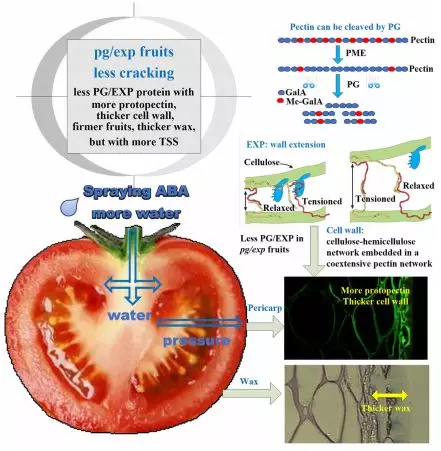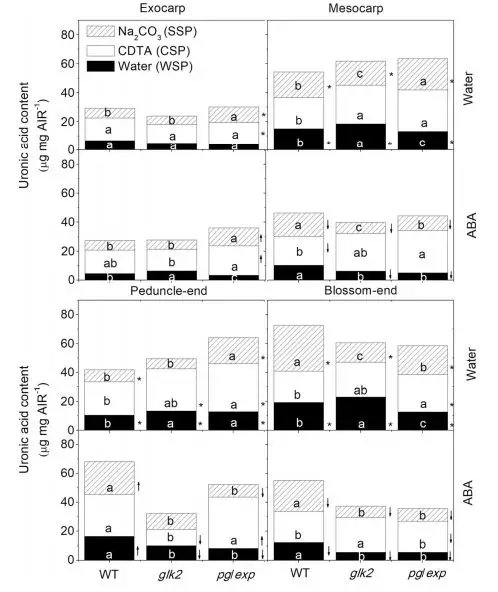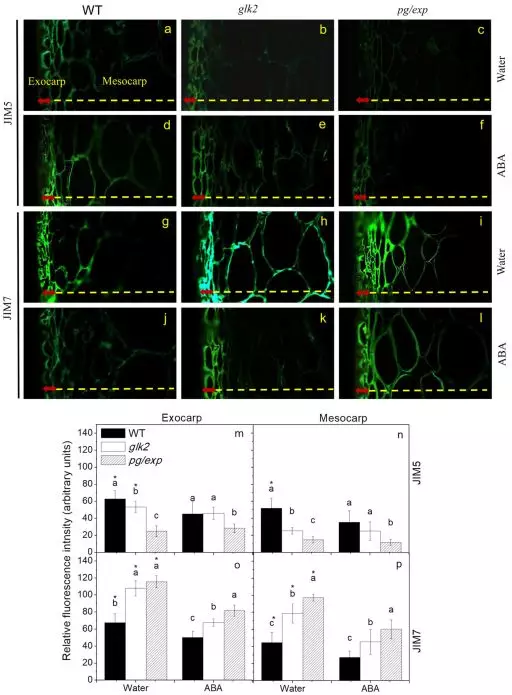论文标题:Disassembly of the fruit cell wall by the ripening-associated polygalacturonase and expansin influences tomato cracking
期刊:Horticulture Research
作者:Fangling Jiang, Alfonso Lopez, Shinjae Jeon, Sergio Tonetto de Freitas, Qinghui Yu, Zhen Wu, John M. Labavitch, Shengke Tian, Ann L. T. Powell, Elizabeth Mitcham
发表时间:2019/02/01
数字识别码: 10.1038/s41438-018-0105-3
原文链接:https://www.nature.com/articles/s41438-018-0105-3?utm_source=sciencenet&utm_
medium=display&utm_content=mpu&utm_campaign=JRCN_2_JG_sciencenet_hortres_disassembly
微信链接:https://mp.weixin.qq.com/s/Xax7MYGqo4zkyrVVC4Fr7g

图1
点击获取全文PDF: https://www.nature.com/articles/s41438-018-0105-3.pdf
近日,Horticulture Research 在线发表了南京农业大学蔬菜生理生态研究团队(吴震,蒋芳玲),以及加州大学戴维斯分校 Ann L. T. Powell和Elizabeth Mitcham研究团队合作完成的题为“Disassembly of the fruit cell wall by the ripening-associated polygalacturonase and expansin influences tomato cracking”的研究论文。论文发现同时抑制PG和EXP基因表达可显著降低番茄的裂果率,并分析了其调控机制,该研究丰富了裂果的分子机理。
裂果(cracking)是果实类园艺作物生产中亟待解决的重要问题,是指果实成熟或发育过程中果皮开裂的现象。果实产生裂痕后,会影响其外观品质、缩短货架期,甚至会感染霉菌,使果实商品价值降低甚至丧失,极大妨碍了果品的生产与销售。培育耐裂果品种是解决裂果问题的重要途径,而探明裂果的分子机制对耐裂果新品种选育有重要的指导意义。前人研究认为,裂果属于多基因控制的数量性状。该研究以番茄为材料,发现同时抑制多聚半乳糖醛酸酶(polygalacturonase, PG)和扩张蛋白(expansin, EXP)基因表达的株系(pg/exp),其裂果率显著低于野生型(Alisa Craig,AC)。PG能降解果胶骨架,EXP是一种非酶类的细胞壁活性蛋白,二者均能使植物细胞壁松弛、果实变软。与野生型相比,pg/exp果实中PG和EXP蛋白表达下调,果皮中水溶性果胶含量减少,原果胶量含量升高,细胞壁变厚、果实更硬、蜡质层变厚、果实硬度高,进而使裂果率降低,但果实中含有更多的可溶性固形物,品质更好。该文章同时还研究了glk突变对裂果的影响。GLK基因可提高果实中叶绿素含量,增加果实中糖类物质含量,而糖类物质的积累使水分流向果实,导致果肉组织膨压增大,果皮将承受更大的膨胀压力,若果皮强度较低,则易裂果。前人研究也发现,增加糖类物质含量会导致番茄果实裂果率增加。但该研究发现,glk果实的裂果率与对照(AC)相比差异不显著,但均显著高于pg/exp的果实。可能与糖类物质含量升高引起的果实膨压增加相比,细胞壁强度的增强在调控果实开裂过程中发挥更重要的作用。该研究为培育耐裂果且品质优良的番茄品种提供了理论依据和基因资源。研究中采用ABA喷施番茄植株,促使叶片气孔关闭,使木质部液更多流入果实,增加果实膨压,结合灌溉处理,诱使果实开裂。

图2:Mechanism of ABA treated pg/exp fruit showing less cracking

图3: Water, CDTA, and Na2CO3-solubilized pectins (WSP, CSP, SSP) as measured by the uronic acid equivalents in alcohol-insoluble residues (AIR) prepared from the exocarp and mesocarp portion of red ripe WT, glk2 and pg/exp tomato plants treated with water or ABA

图4:Indirect immunofluorescence detection of pectin esterification in red ripe WT (a, d, g, j), glk2 (b, e, h, k), and pg/exp (c, f, i, l) tomato fruit from plants treated with water (a–c, g–i) or ABA (d–f, j–l). Sections from fruits of each genotype and treatment were analyzed with two monoclonal antibodies, JIM5 (identifies HG pectins with low levels of methyl esterification) (a–f, m, n) and JIM7 (identifies HG pectins with high levels of methyl esterification) (g–l, o, p). Red arrows indicate exocarp and yellow dotted line represents mesocarp
该研究以蒋芳玲为第一作者,Alfonso Lopez,Shinjae Jeon, Sergio Tonetto de Freitas,余庆辉, 吴震,John M. Labavitch,田生科参与了该项研究,Ann L. T. Powell和Elizabeth Mitcham为共同通讯作者。该研究还获得了加州大学戴维斯分校Judy Jernstedt和 Ken Shackel,以及威斯康辛麦迪逊分校Qiang Sun教授的支持。研究由国家自然科学基金(中国)、美国国家科学基金、中央高校基本科研业务费、US NSF support to ALTP提供经费支持。
相关文章链接:
1. Tomato lncRNA23468 functions as a competingendogenous RNA to modulate NBS-LRR genes by decoying miR482b in thetomato-Phytophthora infestans interaction
2. SlMYB75, an MYB-type transcription factor, promotes anthocyanin accumulation and enhances volatile aroma production in tomato fruits
3. Diversity and redundancy of the ripening regulatory networks revealed by the fruitENCODE and the new CRISPR/Cas9 CNR and NOR mutants
4. A NAC transcription factor, NOR-like1, is a new positive regulator of tomato fruit ripening
摘要:Fruit cracking is an important problem in horticultural crop production. Polygalacturonase (SlPG) and expansin (SlEXP1) proteins cooperatively disassemble the polysaccharide network of tomato fruit cell walls during ripening and thereby, enable softening. A Golden 2-like (GLK2) transcription factor, SlGLK2 regulates unripe fruit chloroplast development and results in elevated soluble solids and carotenoids in ripe fruit. To determine whether SlPG, SlEXP1, or SlGLK2 influence the rate of tomato fruit cracking, the incidence of fruit epidermal cracking was compared between wild-type, Ailsa Craig (WT) and fruit with suppressed SlPG and SlEXP1 expression (pg/exp) or expressing a truncated nonfunctional Slglk2 (glk2). Treating plants with exogenous ABA increases xylemic flow into fruit. Our results showed that ABA treatment of tomato plants greatly increased cracking of fruit from WT and glk2 mutant, but not from pg/exp genotypes. The pg/exp fruit were firmer, had higher total soluble solids, denser cell walls and thicker cuticles than fruit of the other genotypes. Fruit from the ABA treated pg/exp fruit had cell walls with less water-soluble and more ionically and covalently-bound pectins than fruit from the other lines, demonstrating that ripening-related disassembly of the fruit cell wall, but not elimination of SlGLK2, influences cracking. Cracking incidence was significantly correlated with cell wall and wax thickness, and the content of cell wall protopectin and cellulose, but not with Ca2+content.
阅读论文全文请访问:https://www.nature.com/articles/s41438-018-0105-3?utm_source=sciencenet&utm_
medium=display&utm_content=mpu&utm_campaign=JRCN_2_JG_sciencenet_hortres_disassembly
期刊介绍:Horticulture Research is an online-only, open access international journal devoted to publish original research results and reviews on, but not limited to, genetics, genomics and breeding, biotechnology, biochemistry, physiology, cellular and molecular biology, evolution, and environmental biology of horticultural plants. The journal is published by Springer Nature in partnership with Nanjing Agricultural University. The journal also publishes News and Views on current events and hot topics in global horticultural fields. The journal aims to become a highly respected and trusted resource of cutting-edge information in the field of horticulture. The journal will also provide a much-needed platform to promote worldwide academic exchange.
(来源:科学网)
特别声明:本文转载仅仅是出于传播信息的需要,并不意味着代表本网站观点或证实其内容的真实性;如其他媒体、网站或个人从本网站转载使用,须保留本网站注明的“来源”,并自负版权等法律责任;作者如果不希望被转载或者联系转载稿费等事宜,请与我们接洽。